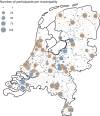Nationwide seroprevalence of SARS-CoV-2 and identification of risk factors in the general population of the Netherlands during the first epidemic wave
- PMID: 33249407
- PMCID: PMC8142429
- DOI: 10.1136/jech-2020-215678
Nationwide seroprevalence of SARS-CoV-2 and identification of risk factors in the general population of the Netherlands during the first epidemic wave
Abstract
Background: We aimed to detect SARS-CoV-2 serum antibodies in the general population of the Netherlands and identify risk factors for seropositivity amidst the first COVID-19 epidemic wave.
Methods: Participants (n=3207, aged 2-90 years), enrolled from a previously established nationwide serosurveillance study, provided a self-collected fingerstick blood sample and completed a questionnaire (median inclusion date 3 April 2020). IgG antibodies targeted against the spike S1-protein of SARS-CoV-2 were quantified using a validated multiplex-immunoassay. Seroprevalence was estimated controlling for survey design, individual pre-pandemic concentration, and test performance. Random-effects logistic regression identified risk factors for seropositivity.
Results: Overall seroprevalence in the Netherlands was 2.8% (95% CI 2.1 to 3.7), with no differences between sexes or ethnic background, and regionally ranging between 1.3 and 4.0%. Estimates were highest among 18-39 year-olds (4.9%), and lowest in children 2-17 years (1.7%). Multivariable analysis revealed that persons taking immunosuppressants and those from the Orthodox-Reformed Protestant community had over four times higher odds of being seropositive compared to others. Anosmia/ageusia was the most discriminative symptom between seropositive (53%) and seronegative persons (4%, p<0.0001). Antibody concentrations in seropositive persons were significantly higher in those with fever or dyspnoea in contrast to those without (p=0.01 and p=0.04, respectively).
Conclusions: In the midst of the first epidemic wave, 2.8% of the Dutch population was estimated to be infected with SARS-CoV-2, that is, 30 times higher than reported. This study identified independent groups with increased odds for seropositivity that may require specific surveillance measures to guide future protective interventions internationally, including vaccination once available.
Keywords: Epidemics; Epidemiology; Infection; Public health; Surveillance.
© Author(s) (or their employer(s)) 2020. Re-use permitted under CC BY-NC. No commercial re-use. See rights and permissions. Published by BMJ.
Conflict of interest statement
Competing interests: None declared.
Figures


Similar articles
-
Seroprevalence of SARS-CoV-2 antibodies among healthcare workers in Dutch hospitals after the 2020 first wave: a multicentre cross-sectional study with prospective follow-up.Antimicrob Resist Infect Control. 2023 Nov 29;12(1):137. doi: 10.1186/s13756-023-01324-x. Antimicrob Resist Infect Control. 2023. PMID: 38031155 Free PMC article.
-
Seroprevalence of SARS-CoV-2-specific anti-spike IgM, IgG, and anti-nucleocapsid IgG antibodies during the second wave of the pandemic: A population-based cross-sectional survey across Kashmir, India.Front Public Health. 2022 Oct 6;10:967447. doi: 10.3389/fpubh.2022.967447. eCollection 2022. Front Public Health. 2022. PMID: 36276377 Free PMC article.
-
Prevalence of SARS-CoV-2 in Spain (ENE-COVID): a nationwide, population-based seroepidemiological study.Lancet. 2020 Aug 22;396(10250):535-544. doi: 10.1016/S0140-6736(20)31483-5. Epub 2020 Jul 6. Lancet. 2020. PMID: 32645347 Free PMC article.
-
SARS-CoV-2 seropositivity and subsequent infection risk in healthy young adults: a prospective cohort study.Lancet Respir Med. 2021 Jul;9(7):712-720. doi: 10.1016/S2213-2600(21)00158-2. Epub 2021 Apr 15. Lancet Respir Med. 2021. PMID: 33865504 Free PMC article.
-
Pre-Vaccine Positivity of SARS-CoV-2 Antibodies in Alberta, Canada during the First Two Waves of the COVID-19 Pandemic.Microbiol Spectr. 2021 Sep 3;9(1):e0029121. doi: 10.1128/Spectrum.00291-21. Epub 2021 Aug 18. Microbiol Spectr. 2021. PMID: 34406813 Free PMC article.
Cited by
-
Seroprevalence of SARS-CoV-2 antibodies among healthcare workers in Dutch hospitals after the 2020 first wave: a multicentre cross-sectional study with prospective follow-up.Antimicrob Resist Infect Control. 2023 Nov 29;12(1):137. doi: 10.1186/s13756-023-01324-x. Antimicrob Resist Infect Control. 2023. PMID: 38031155 Free PMC article.
-
[Seroprevalence of SARS-CoV-2 among children and adolescents in Germany-an overview].Bundesgesundheitsblatt Gesundheitsforschung Gesundheitsschutz. 2021 Dec;64(12):1483-1491. doi: 10.1007/s00103-021-03448-0. Epub 2021 Nov 3. Bundesgesundheitsblatt Gesundheitsforschung Gesundheitsschutz. 2021. PMID: 34731291 Free PMC article. Review. German.
-
Determinants of having severe acute respiratory syndrome coronavirus 2 neutralizing antibodies in Egypt.Influenza Other Respir Viruses. 2021 Nov;15(6):750-756. doi: 10.1111/irv.12889. Epub 2021 Jul 15. Influenza Other Respir Viruses. 2021. PMID: 34264010 Free PMC article.
-
Persistence of Antibodies to Severe Acute Respiratory Syndrome Coronavirus 2 in Relation to Symptoms in a Nationwide Prospective Study.Clin Infect Dis. 2021 Dec 16;73(12):2155-2162. doi: 10.1093/cid/ciab172. Clin Infect Dis. 2021. PMID: 33624751 Free PMC article.
-
Estimating the strength of selection for new SARS-CoV-2 variants.medRxiv [Preprint]. 2021 Sep 24:2021.03.29.21254233. doi: 10.1101/2021.03.29.21254233. medRxiv. 2021. Update in: Nat Commun. 2021 Dec 14;12(1):7239. doi: 10.1038/s41467-021-27369-3. PMID: 33821289 Free PMC article. Updated. Preprint.
References
-
- John Hopkins University . COVID-19 dashboard by the center for systems science and engineering. 2020. Available https://gisanddata.maps.arcgis.com/apps/opsdashboard/index.html#/bda7594... (accessed 2 Jul 2020).
-
- World Health Organization (WHO) . WHO Director-General’s opening remarks at the media briefing on COVID-19-11 March 2020. 2020. Available https://www.who.int/dg/speeches/detail/who-director-general-s-opening-re... (accessed 12 May 2020).
-
- National Institute for Public Health and the Environment (RIVM) . Daily situational report of COVID-19 in the Netherlands - July 2, 2020 (in Dutch). Bilthoven: RIVM, 2020.
LinkOut - more resources
Full Text Sources
Miscellaneous
